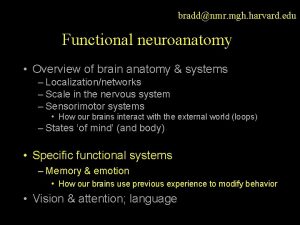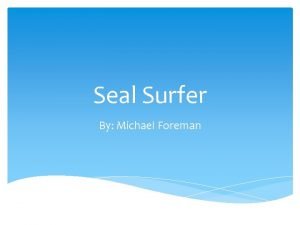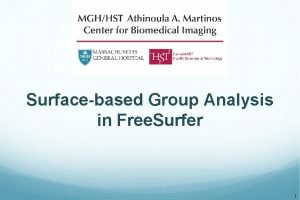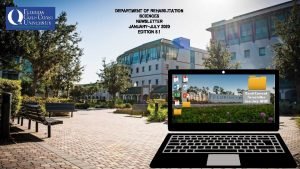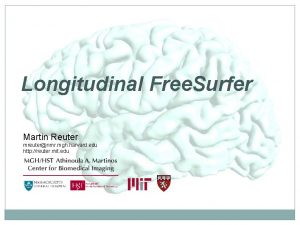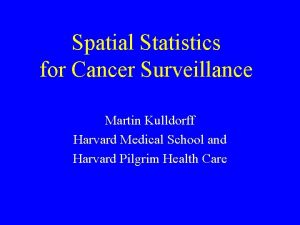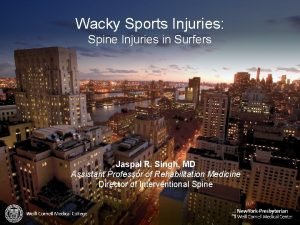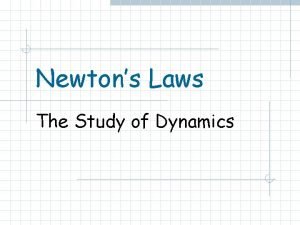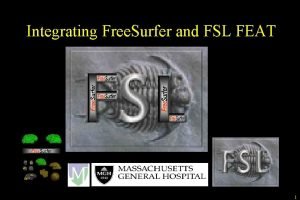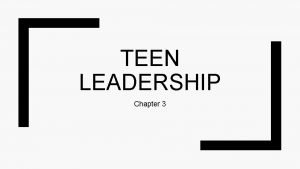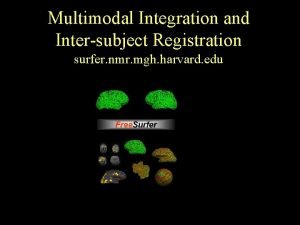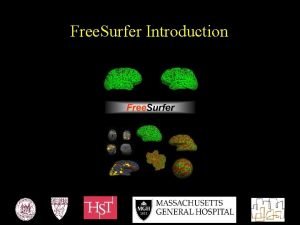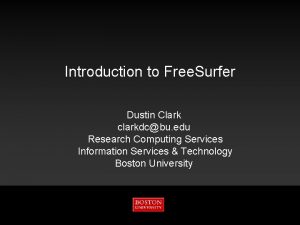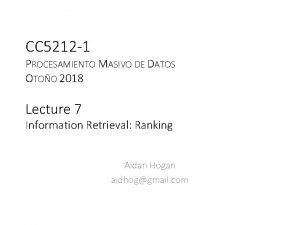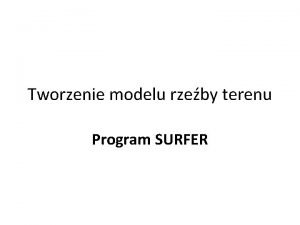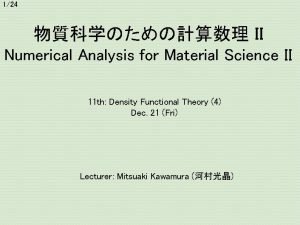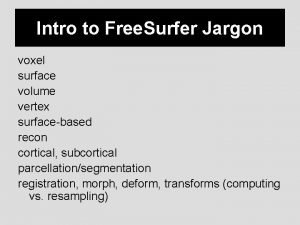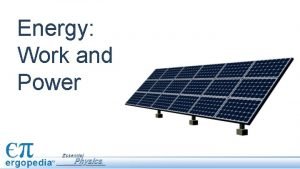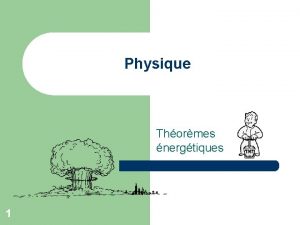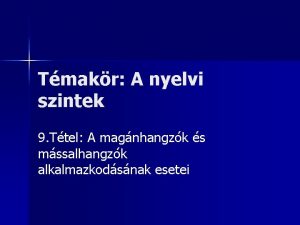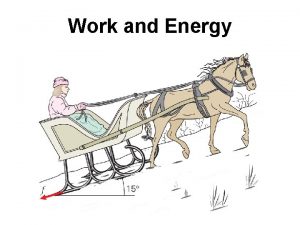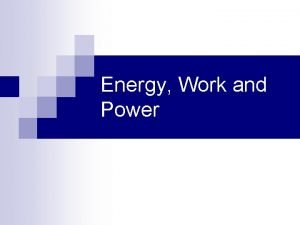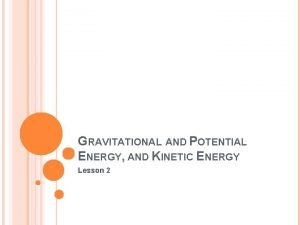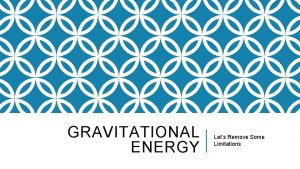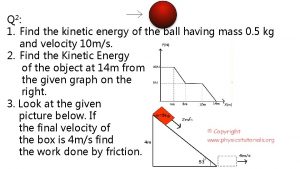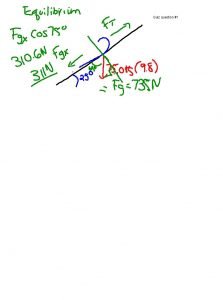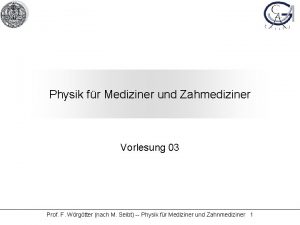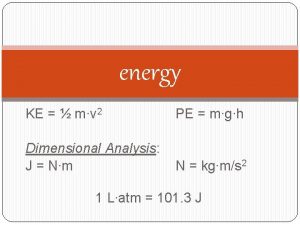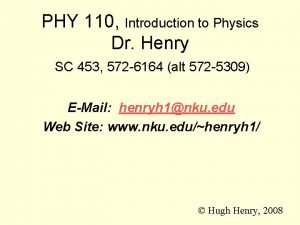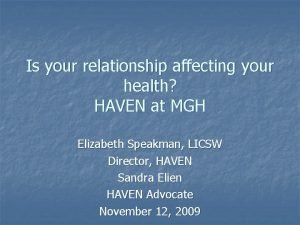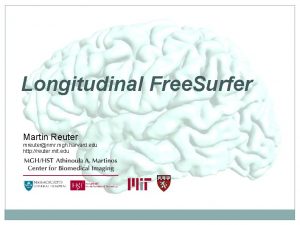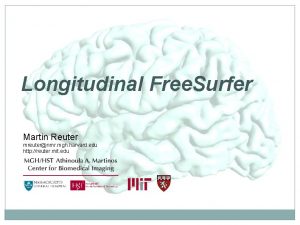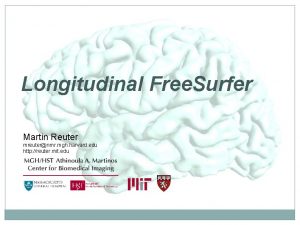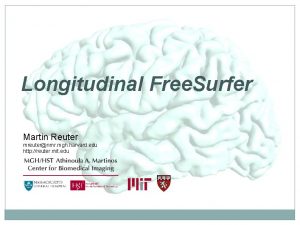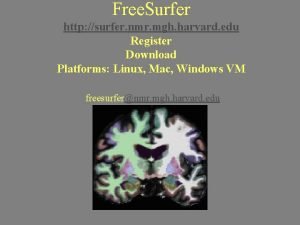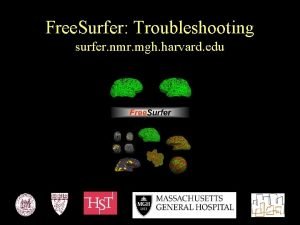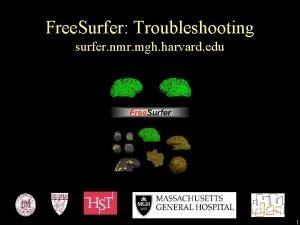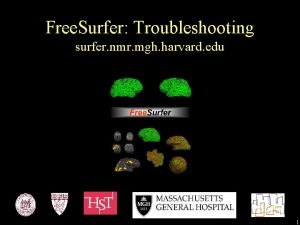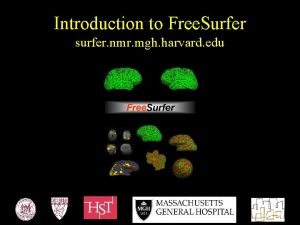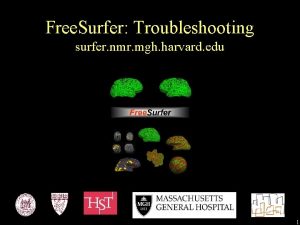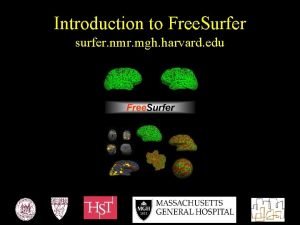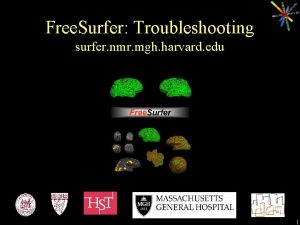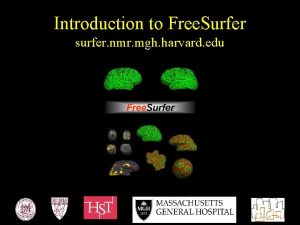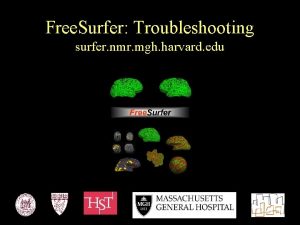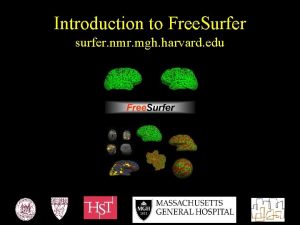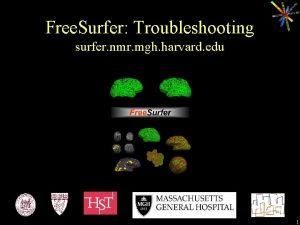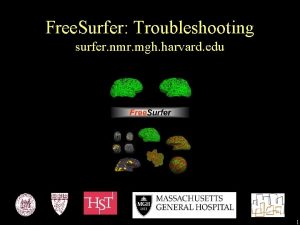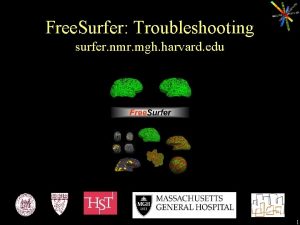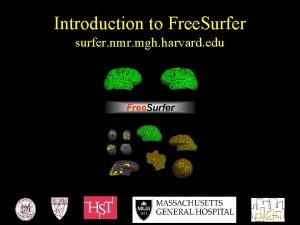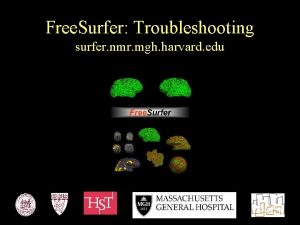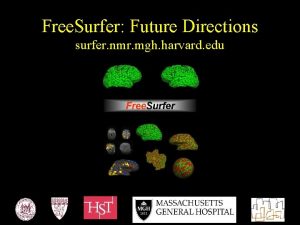Longitudinal Free Surfer Martin Reuter mreuternmr mgh harvard







![Robust Registration [Reuter et al. , Neuro. Image, 2010] Robust Registration [Reuter et al. , Neuro. Image, 2010]](https://slidetodoc.com/presentation_image/d1566c03beb6ae4017c08d343e7b06ee/image-8.jpg)
![Robust Registration [Reuter et al. , Neuro. Image, 2010] Goal: Highly accurate inverse consistent Robust Registration [Reuter et al. , Neuro. Image, 2010] Goal: Highly accurate inverse consistent](https://slidetodoc.com/presentation_image/d1566c03beb6ae4017c08d343e7b06ee/image-9.jpg)
![Robust Registration [Reuter et al. , Neuro. Image, 2010] Inverse consistency: • a symmetric Robust Registration [Reuter et al. , Neuro. Image, 2010] Inverse consistency: • a symmetric](https://slidetodoc.com/presentation_image/d1566c03beb6ae4017c08d343e7b06ee/image-10.jpg)
![Robust Registration [Reuter et al. , Neuro. Image, 2010] Limited contribution of outliers [Nestares&Heeger Robust Registration [Reuter et al. , Neuro. Image, 2010] Limited contribution of outliers [Nestares&Heeger](https://slidetodoc.com/presentation_image/d1566c03beb6ae4017c08d343e7b06ee/image-11.jpg)
![Robust Registration [Reuter et al. , Neuro. Image, 2010] Tumor data courtesy of Dr. Robust Registration [Reuter et al. , Neuro. Image, 2010] Tumor data courtesy of Dr.](https://slidetodoc.com/presentation_image/d1566c03beb6ae4017c08d343e7b06ee/image-12.jpg)
![Robust Registration [Reuter et al 2010] Target Robust Registration [Reuter et al 2010] Target](https://slidetodoc.com/presentation_image/d1566c03beb6ae4017c08d343e7b06ee/image-13.jpg)
![Robust Registration [Reuter et al 2010] Registered Src FSL FLIRT Registered Src Robust Robust Registration [Reuter et al 2010] Registered Src FSL FLIRT Registered Src Robust](https://slidetodoc.com/presentation_image/d1566c03beb6ae4017c08d343e7b06ee/image-14.jpg)










![Biased Information Transfer [Reuter et al. , Neuro. Image, 2012] Subcortical Cortical Biased information Biased Information Transfer [Reuter et al. , Neuro. Image, 2012] Subcortical Cortical Biased information](https://slidetodoc.com/presentation_image/d1566c03beb6ae4017c08d343e7b06ee/image-25.jpg)
![Simulated Atrophy (2% left Hippo. ) [Reuter et al. , Neuro. Image, 2012] Left Simulated Atrophy (2% left Hippo. ) [Reuter et al. , Neuro. Image, 2012] Left](https://slidetodoc.com/presentation_image/d1566c03beb6ae4017c08d343e7b06ee/image-26.jpg)
![Test-Retest Reliability [Reuter et al. , Neuro. Image, 2012] Subcortical Cortical [LONG] significantly improves Test-Retest Reliability [Reuter et al. , Neuro. Image, 2012] Subcortical Cortical [LONG] significantly improves](https://slidetodoc.com/presentation_image/d1566c03beb6ae4017c08d343e7b06ee/image-27.jpg)
![Test-Retest Reliability [Reuter et al. , Neuro. Image, 2012] Diff. ([CROSS]-[LONG]) of Abs. Thick. Test-Retest Reliability [Reuter et al. , Neuro. Image, 2012] Diff. ([CROSS]-[LONG]) of Abs. Thick.](https://slidetodoc.com/presentation_image/d1566c03beb6ae4017c08d343e7b06ee/image-28.jpg)
![Increased Power [Reuter et al. , Neuro. Image, 2012] Left Hemisphere: Right Hemisphere Sample Increased Power [Reuter et al. , Neuro. Image, 2012] Left Hemisphere: Right Hemisphere Sample](https://slidetodoc.com/presentation_image/d1566c03beb6ae4017c08d343e7b06ee/image-29.jpg)
![Huntington’s Disease (3 visits) [Reuter et al. , Neuro. Image, 2012] Independent Processing Longitudinal Huntington’s Disease (3 visits) [Reuter et al. , Neuro. Image, 2012] Independent Processing Longitudinal](https://slidetodoc.com/presentation_image/d1566c03beb6ae4017c08d343e7b06ee/image-30.jpg)
![Huntington’s Disease (3 visits) [Reuter et al. , Neuro. Image, 2012] Rate of Atrophy Huntington’s Disease (3 visits) [Reuter et al. , Neuro. Image, 2012] Rate of Atrophy](https://slidetodoc.com/presentation_image/d1566c03beb6ae4017c08d343e7b06ee/image-31.jpg)







- Slides: 38

Longitudinal Free. Surfer Martin Reuter mreuter@nmr. mgh. harvard. edu http: //reuter. mit. edu

What can we do with Free. Surfer? • measure volume of cortical or subcortical structures • compute thickness (locally) of the cortical sheet • study differences of populations (diseased, control)

We'd like to: • exploit longitudinal information (same subject, different time points)) Why longitudinal? • to reduce variability on intra-individual morph. estimates • to detect small changes, or use less subjects (power) • for marker of disease progression (atrophy) • to better estimate time to onset of symptoms • to study effects of drug treatment. . . [Reuter et al, Neuro. Image 2012]

Example 1

Example 2

Challenges in Longitudinal Designs • Over-Regularization: • Temporal smoothing • Non-linear warps Ø Potentially underestimating change • Bias [Reuter and Fischl, Neuro. Image 2011] , [Reuter et al. Neuro. Image 2012] • Interpolation Asymmetries [Yushkevich et al. 2010] • Asymmetric Information Transfer Ø Often overestimating change • Limited designs: • Only 2 time points • Special purposes (e. g. only surfaces, WM/GM)

How can it be done? • Stay unbiased with respect to any specific time point by treating all the same • Create a within subject template (base) as an initial guess for segmentation and reconstruction • Initialize each time point with the template to reduce variability in the optimization process • For this we need a robust registration (rigid) and template estimation
![Robust Registration Reuter et al Neuro Image 2010 Robust Registration [Reuter et al. , Neuro. Image, 2010]](https://slidetodoc.com/presentation_image/d1566c03beb6ae4017c08d343e7b06ee/image-8.jpg)
Robust Registration [Reuter et al. , Neuro. Image, 2010]
![Robust Registration Reuter et al Neuro Image 2010 Goal Highly accurate inverse consistent Robust Registration [Reuter et al. , Neuro. Image, 2010] Goal: Highly accurate inverse consistent](https://slidetodoc.com/presentation_image/d1566c03beb6ae4017c08d343e7b06ee/image-9.jpg)
Robust Registration [Reuter et al. , Neuro. Image, 2010] Goal: Highly accurate inverse consistent registrations • In the presence of: • Noise • Gradient non-linearities • Movement: jaw, tongue, neck, eye, scalp. . . • Cropping • Atrophy (or other longitudinal change) We need: • Inverse consistency keep registration unbiased • Robust statistics to reduce influence of outliers
![Robust Registration Reuter et al Neuro Image 2010 Inverse consistency a symmetric Robust Registration [Reuter et al. , Neuro. Image, 2010] Inverse consistency: • a symmetric](https://slidetodoc.com/presentation_image/d1566c03beb6ae4017c08d343e7b06ee/image-10.jpg)
Robust Registration [Reuter et al. , Neuro. Image, 2010] Inverse consistency: • a symmetric displacement model: • resample both source and target to an unbiased half-way space in intermediate steps (matrix square root) Source Half-Way Target
![Robust Registration Reuter et al Neuro Image 2010 Limited contribution of outliers NestaresHeeger Robust Registration [Reuter et al. , Neuro. Image, 2010] Limited contribution of outliers [Nestares&Heeger](https://slidetodoc.com/presentation_image/d1566c03beb6ae4017c08d343e7b06ee/image-11.jpg)
Robust Registration [Reuter et al. , Neuro. Image, 2010] Limited contribution of outliers [Nestares&Heeger 2000] Square Tukey's Biweight
![Robust Registration Reuter et al Neuro Image 2010 Tumor data courtesy of Dr Robust Registration [Reuter et al. , Neuro. Image, 2010] Tumor data courtesy of Dr.](https://slidetodoc.com/presentation_image/d1566c03beb6ae4017c08d343e7b06ee/image-12.jpg)
Robust Registration [Reuter et al. , Neuro. Image, 2010] Tumor data courtesy of Dr. Greg Sorensen Tumor data with significant intensity differences in the brain, registered to first time point (left).
![Robust Registration Reuter et al 2010 Target Robust Registration [Reuter et al 2010] Target](https://slidetodoc.com/presentation_image/d1566c03beb6ae4017c08d343e7b06ee/image-13.jpg)
Robust Registration [Reuter et al 2010] Target
![Robust Registration Reuter et al 2010 Registered Src FSL FLIRT Registered Src Robust Robust Registration [Reuter et al 2010] Registered Src FSL FLIRT Registered Src Robust](https://slidetodoc.com/presentation_image/d1566c03beb6ae4017c08d343e7b06ee/image-14.jpg)
Robust Registration [Reuter et al 2010] Registered Src FSL FLIRT Registered Src Robust

Inverse Consistency of mri_robust_register Inverse consistency of different methods on original (orig), intensity normalized (T 1) and skull stripped (norm) images. LS and Robust: • nearly perfect symmetry (worst case RMS < 0. 02) Other methods: • several alignments with RMS errors > 0. 1 [Reuter et al. , Neuro. Image, 2010]

Accuracy of mri_robust_register Performance of different methods on test-retest scans, with respect to SPM skull stripped brain registration (norm). • The brain-only registrations are very similar • Robust shows better performance for original (orig) or normalized (T 1) full head images [Reuter et al. , Neuro. Image, 2010]

mri_robust_register • mri_robust_register is part of Free. Surfer • can be used for pair-wise registration (optimally within subject, within modality) • can output results in half-way space • can output ‘outlier-weights’ • see also Reuter et al. “Highly Accurate Inverse Consistent Registration: A Robust Approach”, Neuro. Image 2010. http: //reuter. mit. edu/publications/ • for more than 2 images: mri_robust_template

Robust Template Estimation • Minimization problem for N images: • Image Dissimilarity: • Metric of Transformations:

Longitudinal Processing

Robust Unbiased Subject Template 1. Create subject template (iterative registration to median) 2. Process template 3. Transfer to time points 4. Let it evolve there - All time points are treated the same - Minimize overregularization by letting tps evolve freely [Reuter et al. , Neuro. Image, 2012]

Robust Template for Initialization • Unbiased • Reduces Variability • Common space for: - TIV estimation - Skullstrip - Affine Talairach Reg. • Basis for: - Intensity Normalization - Non-linear Reg. - Surfaces / Parcellation

Free. Surfer Commands (recon-all) 1. CROSS (independently for each time point tp. Nid): recon-all -subjid tp. Nid -all 2. BASE (creates template, one for each subject): recon-all -baseid -tp tp 1 id -tp tp 2 id. . . -all 3. LONG (for each time point tp. Nid, passing baseid): recon-all -long tp. Nid baseid -all This creates the final directories tp. Nid. long. baseid

Directory Structure Contains all CROSS, BASE and LONG data: • me 1 • me 2 • me 3 • me_base • me 1. long. me_base • me 2. long. me_base • me 3. long. me_base • you 1 • …

Single time point Since FS 5. 2 you can run subjects with a single time point through the longitudinal stream! • Mixed effects models can use single tp subjects to estimate variance (increased power) • This assures identical processing steps as in a subject with several time points • Commands same as above: recon-all -subjid tp 1 id -all recon-all -baseid -tp tp 1 id -all recon-all -long tp 1 id baseid -all
![Biased Information Transfer Reuter et al Neuro Image 2012 Subcortical Cortical Biased information Biased Information Transfer [Reuter et al. , Neuro. Image, 2012] Subcortical Cortical Biased information](https://slidetodoc.com/presentation_image/d1566c03beb6ae4017c08d343e7b06ee/image-25.jpg)
Biased Information Transfer [Reuter et al. , Neuro. Image, 2012] Subcortical Cortical Biased information transfer: [BASE 1] and [BASE 2]. Our method [FS-LONG] [FS-LONG-rev] shows no bias.
![Simulated Atrophy 2 left Hippo Reuter et al Neuro Image 2012 Left Simulated Atrophy (2% left Hippo. ) [Reuter et al. , Neuro. Image, 2012] Left](https://slidetodoc.com/presentation_image/d1566c03beb6ae4017c08d343e7b06ee/image-26.jpg)
Simulated Atrophy (2% left Hippo. ) [Reuter et al. , Neuro. Image, 2012] Left Hippocampus Right Hippocampus Cross sectional RED, longitudinal GREEN Simulated atrophy was applied to the left hippocampus only
![TestRetest Reliability Reuter et al Neuro Image 2012 Subcortical Cortical LONG significantly improves Test-Retest Reliability [Reuter et al. , Neuro. Image, 2012] Subcortical Cortical [LONG] significantly improves](https://slidetodoc.com/presentation_image/d1566c03beb6ae4017c08d343e7b06ee/image-27.jpg)
Test-Retest Reliability [Reuter et al. , Neuro. Image, 2012] Subcortical Cortical [LONG] significantly improves reliability 115 subjects, ME MPRAGE, 2 scans, same session
![TestRetest Reliability Reuter et al Neuro Image 2012 Diff CROSSLONG of Abs Thick Test-Retest Reliability [Reuter et al. , Neuro. Image, 2012] Diff. ([CROSS]-[LONG]) of Abs. Thick.](https://slidetodoc.com/presentation_image/d1566c03beb6ae4017c08d343e7b06ee/image-28.jpg)
Test-Retest Reliability [Reuter et al. , Neuro. Image, 2012] Diff. ([CROSS]-[LONG]) of Abs. Thick. Change: Significance Map [LONG] significantly improves reliability 115 subjects, ME MPRAGE, 2 scans, same session
![Increased Power Reuter et al Neuro Image 2012 Left Hemisphere Right Hemisphere Sample Increased Power [Reuter et al. , Neuro. Image, 2012] Left Hemisphere: Right Hemisphere Sample](https://slidetodoc.com/presentation_image/d1566c03beb6ae4017c08d343e7b06ee/image-29.jpg)
Increased Power [Reuter et al. , Neuro. Image, 2012] Left Hemisphere: Right Hemisphere Sample Size Reduction when using [LONG]
![Huntingtons Disease 3 visits Reuter et al Neuro Image 2012 Independent Processing Longitudinal Huntington’s Disease (3 visits) [Reuter et al. , Neuro. Image, 2012] Independent Processing Longitudinal](https://slidetodoc.com/presentation_image/d1566c03beb6ae4017c08d343e7b06ee/image-30.jpg)
Huntington’s Disease (3 visits) [Reuter et al. , Neuro. Image, 2012] Independent Processing Longitudinal Processing [LONG] shows higher precision and better discrimination power between groups (specificity and sensitivity).
![Huntingtons Disease 3 visits Reuter et al Neuro Image 2012 Rate of Atrophy Huntington’s Disease (3 visits) [Reuter et al. , Neuro. Image, 2012] Rate of Atrophy](https://slidetodoc.com/presentation_image/d1566c03beb6ae4017c08d343e7b06ee/image-31.jpg)
Huntington’s Disease (3 visits) [Reuter et al. , Neuro. Image, 2012] Rate of Atrophy Baseline Vol. (normalized) Putamen Atrophy Rate can is significant between CN and PHD far, but baseline volume is not.

Final Remarks …

Sources of Bias during Acquisition BAD: these influence the images directly and cannot be easily removed! • Different Scanner Hardware (Headcoil, Pillow? ) • Different Scanner Software (Shimming Algorithm) • Scanner Drift and Calibration • Different Motion Levels Across Groups • Different Hydration Levels (season, time of day)

Hydration Levels 14 subjects, 12 h dehydration, rehydration 1 L/h [with A. Bartsch et al. – submitted]

Still to come … • Common warps (non-linear) • Intracranial volume estimation • Joint intensity normalization • New thickness computation • Joint spherical registration http: //freesurfer. net/fswiki/Longitudinal. Processing http: //reuter. mit. edu/publications Thanks to: the Free. Surfer Team

Longitudinal Tutorial

Longitudinal Tutorial 1. How to process longitudinal data • Three stages: CROSS, BASE, LONG 2. Post-processing (statistical analysis): • (i) compute atrophy rate within each subject • (ii) group analysis (average rates, compare) • here: two time points, rate or percent change 3. Manual Edits • Start in CROSS, do BASE, then LONGs should be fixed automatically • Often it is enough to just edit the BASE • See http: //freesurfer. net/fswiki/Longitudinal. Edits

Longitudinal Tutorial • Temporal Average • Rate of Change • Percent Change (w. r. t. time 1) • Symmetrized Percent Change (w. r. t. temp. avg. )
 Mgh.harvard.edu
Mgh.harvard.edu Dock foreman meaning
Dock foreman meaning Mris_preproc
Mris_preproc Peter reuter fgcu
Peter reuter fgcu Jeanie reuter
Jeanie reuter Niklas reuter
Niklas reuter Reuter
Reuter Martin kulldorff harvard
Martin kulldorff harvard Surfer myelopathy
Surfer myelopathy A surfer hangs ten and accelerates
A surfer hangs ten and accelerates Tksurfer
Tksurfer Interpersonal skills in soul surfer
Interpersonal skills in soul surfer Surfer
Surfer Surfer
Surfer Surfer
Surfer Pseudopotential
Pseudopotential Surfer
Surfer Random surfer model
Random surfer model Program surfer
Program surfer 河村光晶
河村光晶 Free
Free Energy is force times distance
Energy is force times distance Eric rosenberg md
Eric rosenberg md Ep= mgh
Ep= mgh Ajakhangok
Ajakhangok Erisone queues
Erisone queues Si unit of work
Si unit of work Work energy theorem
Work energy theorem Eg=mgh
Eg=mgh Clue cells
Clue cells Eg = mgh
Eg = mgh Mgh formula
Mgh formula Epg=mgh
Epg=mgh Physik
Physik Dimension of p.e=mgh
Dimension of p.e=mgh Parallel plate equipotential lines
Parallel plate equipotential lines Mgh formula
Mgh formula Mgh haven
Mgh haven Sueu unidades
Sueu unidades
